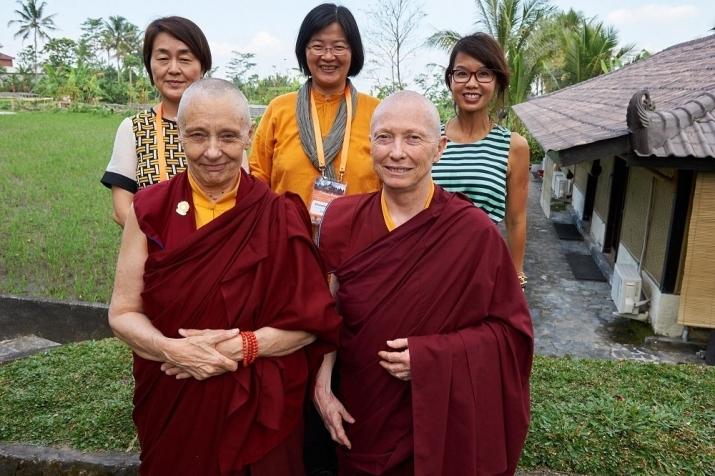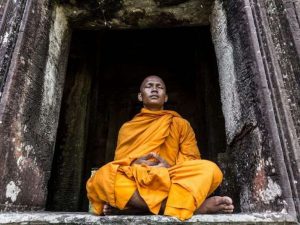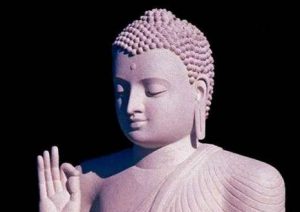
“We thought it would be just a small tea party,” says Venerable Karma Lekshe Tsomo. Reflecting back on the first Sakyadhita conference in Bodh Gaya, India, in 1987, she recalls a small group of Buddhist nuns gathering to talk about their circumstances. They had been struggling to support their studies financially, as well as witnessing the poverty, illiteracy, and desperation of women fleeing Tibet. “That whole week we sat under a tent, in the grass, in a circle on the ground, and discussed our circumstances—what we were thinking, what we were experiencing, the great ideals and hopes and respect that we had for the Dharma and the keen interest that we had to learn more, but finding it very difficult,” she recalls. In the end, about 1,500 people showed up to the opening ceremony, far outstripping expectations. “That’s when we realized we needed to continue the conversation,” she says.
Thus was born the Sakyadhita International Association of Buddhist Women, the “Daughters of the Buddha,” an organization that Lekshe—as she is known in the United States—and a team of volunteers have run for nearly 30 years. Sakyadhita has become a worldwide forum for Buddhist women and a place for scholars, practitioners, artists, and laypeople to come together. Complementing Sakyadhita’s push to improve Buddhist women’s lives, Lekshe’s education project, the Jamyang Foundation, focuses on education for Himalayan women, helping them gain access to texts in their own religion.
Decades of work by Buddhist women around the world have led to a fulcrum moment in Buddhism, when full monastic ordination is becoming more widely discussed and accepted for women in the two traditions (Theravada and Tibetan lineages) where it has not been possible for centuries. Much of this progress is due to women like Lekshe and her colleagues pushing for the inclusion of women’s voices in the global conversation. Now, women who have been educated over the previous decades are beginning to bring their stories and voices to the forefront. This March, on International Women’s Day, I talked with Venerable Lekshe about how 30 years of work in educating and advocating for Buddhist women is finally starting to ripen into rippling, worldwide results.
When Lekshe was studying in India during the 1970s and ’80s, monastic women often struggled to support themselves. “Men had many opportunities and women had virtually none, so the idea was to create some opportunities, some balance, and see what happened,” Lekshe tells me. “At that time, people said women weren’t interested in Buddhist philosophy and all they wanted to do was recite om mani padme hum . . . But contrary to this common narrative, these nuns were very keen on education.”

During her time at the Institute of Buddhist Dialectics, where she studied for six years, Lekshe realized that many refugee nuns were illiterate and desperate to study the teachings of the Dalai Lama. However, some were older, and didn’t really believe they could learn to read. They asked Lekshe for help: “Within two months, all 11 of them—even the one who was 63 years old—did learn. That attracted other nuns, who requested classes on Tibetan grammar. Once they could learn to read, they wanted to figure out how to put words together . . . Then they wanted to study Buddhist philosophy, so with great difficulty I found someone who was willing to teach them Buddhist philosophy. Then they decided they wanted to learn English!”
Eventually, Lekshe saw that Himalayan women were gathering “the tools to write their own stories.” She continued to work and study in India, and eventually Sakyadhita grew into an organization with branches in nine countries so far and a biannual international conference. The Bodh Gaya “tea party” evolved into a multi-faceted event—part academic conference, part global advocacy conversation, part meditation and arts retreat. Much of the academic focus grew naturally, as those involved pursued higher studies in Buddhism; but it also gave the conference credibility, says Lekshe. A major focus of Sakyadhita has been the study of women practitioners’ stories, including those from the earliest Buddhist texts. The “excavation of narratives,” as she calls it, helps to create models for a new generation, as well as to establish that women have been dedicated to Buddhism throughout history. “The Sakyadhita conference has helped to open some doors” by encouraging scholarly work on women in Buddhist countries, Lekshe says.
Sakyadhita’s scholarly approach segues with Lekshe’s interest in Buddhist educational equity. “Without education, people don’t have confidence to speak their truth,” she tells me. “Now we’re 30 years down the road, and it took quite a lot of catch-up for women to start learning to read. Now we’re seeing the wonderful results of those education programs.”
Despite the progress, education for many nuns can only go so far before hitting institutional barriers. In the Tibetan Mulasarvastivada tradition, no living lineage for bhikshuni (fully ordained nuns) exists; only the Chinese Dharmagupta tradition has maintained an unbroken lineage. This has had a material effect on women’s ability to devote themselves to Buddhism. The issue is a practical one; fully ordained nuns receive more support, both material and moral. “The nuns don’t get nearly the same level of support as the monks, in any Buddhist culture,” says Lekshe. “That makes it very difficult for nuns and laywomen to devote time to study instead of, you know, feeding themselves.”
This seems to be changing, in some important ways. The currently serving president of Sakyadhita International, Venerable Jetsunma Tenzin Palmo, commented on the changes: “Up until very recently, it was just taken for granted that nuns learned a few very simple pujas, served the monastery, and prayed hard to come back in a male body next time. Maybe 25 years ago, that began to change, because of people like Lekshe . . . Gradually, that just took off, so now almost all nunneries have a study program. Now, nobody thinks that’s strange at all,” she told Buddhistdoor Global in October 2015. She added that women can now receive the Geshe degree, the highest academic degree in Tibetan Buddhist studies.

In 2015, the 17th Gyalwang Karmapa announced his intention to begin restoring the initial stages of nuns’ vows in the Tibetan tradition, paving the first stones on the road to bhikshuni ordination. Although heartened by the announcement, Lekshe says many women in her tradition are still told that bhikshuni ordination is unnecessary for them.
“Power structures are difficult to change. This requires time, it requires understanding, it requires skillful means,” she says. The theme of the 2015 Sakyadhita International Conference in Indonesia was “Compassion and Social Justice,” and for Lekshe, these two ideals are integrally linked in the path to liberation. For her, social justice work has nothing to do with confrontation and everything to do with the Buddha’s message: “From a Buddhist perspective . . . if we’re serious about trying to liberate living beings from suffering, then we have to be realistic about the circumstances in which most of the world’s people live and generate a commitment to try to do something to help the situation,” she says. “If we work from compassion and loving-kindness, all things are possible.”
When asked what the next 30 years hold, Lekshe laughs. “Well, you know, Buddhists are supposed to live in the moment,” she says coyly. But she adds that the trajectory has been positive: “We never dreamed that so many important changes would happen for Buddhist women as we’ve seen in the last 30 years. Having women take the Geshe degree, or build a monastery in downtown Bangkok, or create women’s shelters and old folks’ homes and orphanages and become university professors . . . all of this was completely beyond imagination when we began our work. If things continue as they are, the future looks very, very bright.”
See more
Sakyadhita
Sakyadhita Facebook
Jamyang Foundation
Interview with Jetsunma Tenzin Palmo (Buddhistdoor Global)
Daughters of Buddha on Etsy.com













